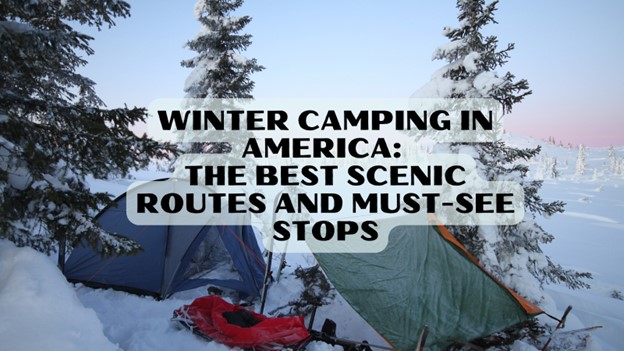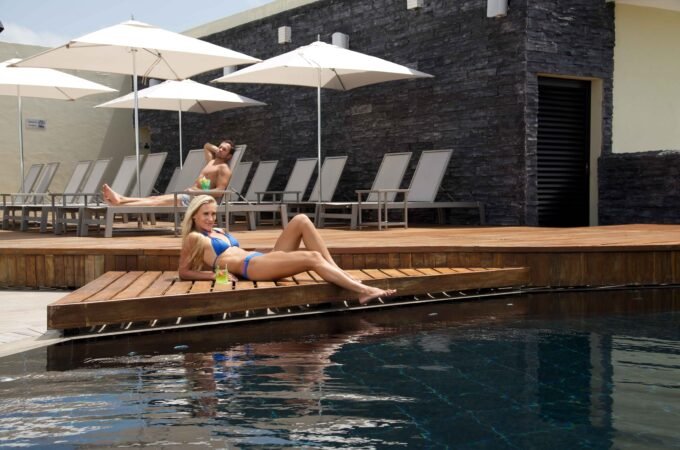
Winter Camping in America: The Best Scenic Routes and Must-See Stops
Why wait indoors during the winter when you can bundle up and pack your tent? Embrace the beauty of snow and chilly air through winter camping. The iconic parks and forests of America turn into wonderlands as the temperatures drop and snowflakes fall. There’s nothing like waking up in a snow-covered forest with a steaming cup of coffee.
In this guide, we’ll provide insider tips on the awe-inspiring destinations for winter camping across the country. You’ll discover how to prepare yourself so that you can comfortably camp in freezing temperatures. Embrace this thrilling season. You might just find that winter camping has become your new favorite adventure.
We’ll recommend spots. Help you gather all the essential gear to ensure warmth and coziness throughout the night. Get ready to create memories while enjoying the magic of winter camping.
The Best Winter Camping Routes
Before we delve into the details of the best winter camping routes, it’s essential to ensure that you pack the necessary items for the best experience. These essential pieces of equipment include high-quality cold-weather sleeping bags, reliable cold-weather clothing, and, of course, the best hot tents, which will serve as your warm and comfortable sanctuary amidst the winter wonderland.
The Natchez Trace Parkway
The Natchez Trace Parkway spans 444 miles from Nashville, Tennessee, to Natchez, Mississippi. It follows an old Native American trail and trade route. The parkway has beautiful views, historic sites, and great camping options. Winters are mild here, making it a comfortable winter camping destination. Campgrounds like Jeff Busby, Rocky Springs, and Pharr Mounds have RV and tent sites.
The Blue Ridge Parkway
The Blue Ridge Parkway connects Shenandoah National Park to the Great Smoky Mountains. It runs 469 miles along the Appalachian Mountains through Virginia and North Carolina. The views of snow-capped peaks and forests are stunning in winter. Some campgrounds like Peaks of Otter and Julian Price stay open year-round for RVs and tents.

The Ice Age National Scenic Trail
Stretching 1200 miles across Wisconsin, this trail follows the path of ancient glaciers. Sections wind through beautiful state and national forests. Winter is a special time to hike and camp here when Everything glistens with snow and ice. There are hundreds of campgrounds along the way in state parks, forests, and trailside shelters.
Top Winter Camping Destinations
Yellowstone National Park
Yellowstone in Wyoming offers unique winter camping adventures. Visitors can glamp in heated cabins, snowshoe to backcountry sites, or car camp beside iconic spots like Old Faithful. Winter brings far fewer crowds, allowing you to experience Yellowstone’s geysers, canyons, and wildlife in solitude.
Glacier National Park
Montana’s Glacier National Park transforms into a snowy wonderland each winter. Several campgrounds stay open for cold-weather camping, including Apgar, St. Mary, and Avalanche Creek. You’ll also find backcountry campsites to sled and ski to while admiring Glacier’s frosted peaks.
Bryce Canyon National Park
Utah’s Bryce Canyon is magical to explore in winter. The vibrant red rock hoodoos contrast beautifully with the white snow. Winter camping is available at North Campground, with easy access to snowshoeing trails. The clear skies offer perfect stargazing too.

Staying Safe in Winter Conditions
Heading out into the backcountry to camp in winter requires extra precautions and preparation. Follow these safety tips to make sure your cold-weather camping trip goes smoothly.
Check the Forecast
Keep an eye on weather reports leading up to your trip. Winter storms can bring heavy snowfall, high winds, and freezing temperatures. If a storm is approaching, consider rescheduling. Getting caught in a blizzard while camping could become a life-threatening emergency.
Know Avalanche Risks
If your route travels through avalanche terrain, check avalanche forecasts from the Avalanche Information Center. Learn how to identify risky slope angles, aspects, and terrain traps. Carry beacons, probes, and shovels and know how to use them if traveling in avalanche-prone areas.
Bring Emergency Supplies
Tell someone your exact route and expected return time. Pack extra food, water, and fuel in case you get stuck waiting out a storm. Bring emergency blankets, hand warmers, extra socks, and a first aid kit. Lightweight microspikes or snowshoes can help prevent falls on icy trails.
Layer Up
Dress in moisture-wicking synthetic layers to stay dry and insulated. Avoid cotton which absorbs moisture. Wear waterproof and windproof outer layers. Make sure your boots or shoes are properly insulated and waterproof. Bring extra wool socks. Wear gaiters over your pants to keep snow out of your boots.
Stay Hydrated
Dehydration comes on faster in the cold for a few reasons. The dry air causes fluids to evaporate from your body faster. And you don’t always feel thirsty when it’s cold out. Drink plenty of warm fluids like broth throughout the day. Insulated water bottles help keep your water from freezing.
Watch for Hypothermia
Know the warning signs of hypothermia – shivering, slurred speech, clumsy movements, and fatigue. If a member of your group starts exhibiting signs, get them into dry clothes and a sleeping bag. Give them warm, non-alcoholic drinks. Place hot packs at major pulse points. Get medical help if symptoms worsen.
Set Up Camp Correctly
Look for protected campsites that are flat and well-drained. Avoid setting up under snow-laden trees which could dump snow on your tent. Dig a trench around the tent to keep melting snow from pooling under it. Place a tarp under your tent for insulation from the snow. Stake your tent securely to withstand high winds.
Staying safe while winter camping requires diligent preparation, packing proper gear and supplies, monitoring conditions, and practicing safe camping techniques. But taking these precautions allows you to comfortably enjoy snowy backcountry adventures.

Frequently Asked Questions
What should I know before winter camping?
- Prepare for freezing temperatures and snow
- Bring a cold-rated sleeping bag and tent
- Pack warm layers and waterproof boots
- Know how to safely use a camp stove in the cold
- Pick campsites with a wind block if possible
What’s the most important winter camping skill to master?
Learning how to start a campfire in snowy conditions is a must! This critical skill helps you quickly get a blaze going to cook meals, melt snow for drinking water, and keep warm in frigid temps. Gather tinder and kindling from the undersides of trees so they’re dry. Make fire starters by coating cotton balls or dryer lint with petroleum jelly. Clear all snow from your fire ring and make a wind break from a log or large rocks. With the right technique, you’ll be a fire master in no time!
How can I stay warm and prevent hypothermia?
- Dress in moisture-wicking layers
- Stay hydrated with warm fluids
- Eat energy-dense foods to fuel your body
- Put on dry clothes if your layers get wet
- Sleep in a winter-rated sleeping bag
Final Thoughts
There’s nothing quite like winter camping to see America’s natural wonders in a brand new light. Bundle up tight and you’ll get to experience the peace and beauty of scenic spots across the country from a totally different angle. The snow-topped mountains along the Blue Ridge Parkway or the steaming geothermal hot spots in Yellowstone – these places transform into magical winter wonderlands once the temperatures really start to drop.
There are so many amazing spots to pitch your tent or park your camper surrounded by gorgeous snowy landscapes. Just make sure to pack all the right cold-weather gear, like a toasty sleeping bag and a stove to heat up some cocoa. Check the forecast and trail conditions too so you know what to expect weather-wise. Then you’ll be all set for an unforgettable and comfortable winter camping trip embraced by snowy solitude.




